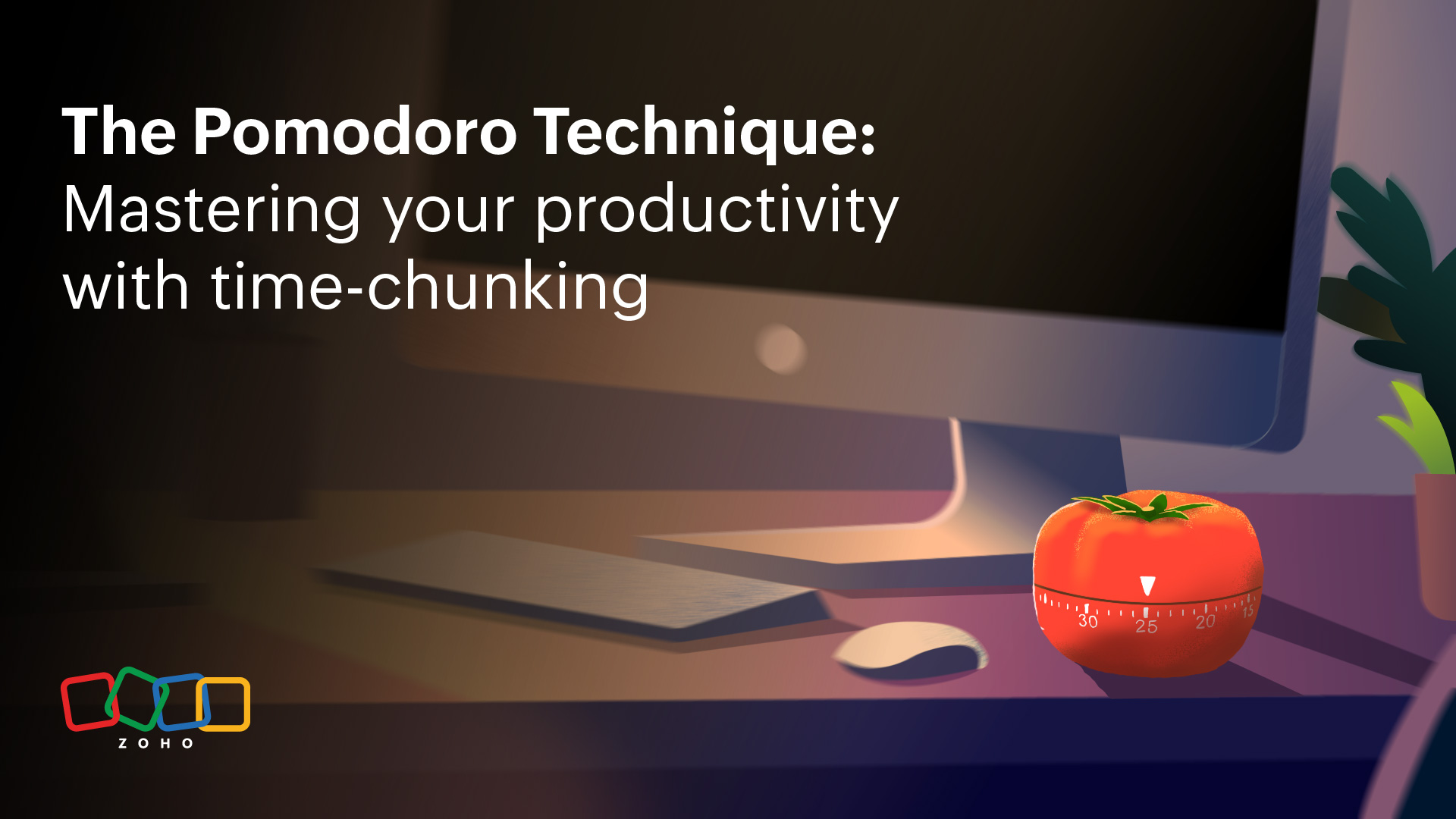- HOME
- All Topics
- Productivity in the workplace
- The Pomodoro Technique: How to master your productivity with time-chunking
The Pomodoro Technique: How to master your productivity with time-chunking
- Published : November 28, 2024
- Last Updated : December 20, 2024
- 1.9K Views
- 7 Min Read
In a world filled with endless distractions, staying productive can feel like an uphill battle. Deadlines loom, inboxes overflow, and focus becomes increasingly elusive. What if there was a simple yet effective way to help you maintain laser-sharp concentration while still giving your brain the rest it craves?
Enter the Pomodoro Technique, a time-management strategy that turns procrastination into progress, one pomodoro at a time. Let's explore how this technique can reshape the way you work, helping you transform busy days into productive ones.

What is the Pomodoro Technique?
Developed by Francesco Cirillo in the late 1980s, the Pomodoro Technique is a time management system that uses intervals, traditionally 25 minutes long, known as "pomodoros."
Named after the tomato-shaped kitchen timer Cirillo used during his university days (pomodoro means tomato in Italian), this method is designed to help people stay focused on tasks by breaking work into manageable segments.
Each 25-minute interval is followed by a short break, typically 5 minutes, allowing you to reset and refresh before diving back in.
The simplicity of the Pomodoro Technique lies in its formula: Work for 25 minutes, take a 5-minute break, and repeat. After completing four pomodoros, you reward yourself with a longer break of 15 to 30 minutes. This cyclical approach is not only effective for maximizing productivity but also combats mental fatigue, keeping you fresh throughout the day.
Why does the Pomodoro Technique work?
The Pomodoro Technique is more than just a quirky way to use a timer; it's based on the psychological principles of focus, rest, and repetition. Here are some reasons why this method is so effective:
It combats procrastination: Facing a massive project can feel overwhelming, often leading to procrastination. By breaking tasks into smaller, 25-minute chunks, the Pomodoro Technique makes any daunting project feel manageable.
It enhances focus: Committing to uninterrupted focus for 25 minutes is more realistic for most people than trying to concentrate for hours on end. Knowing that a break is always around the corner makes it easier to dive in with undivided attention.
It reduces mental fatigue: These frequent short breaks play a crucial role in preventing burnout. Just like physical rest during exercise, mental rest helps the brain recharge, leading to more consistent productivity.
It fosters accountability: Using a timer holds you accountable. There’s something about the ticking clock that forces you to ignore distractions and stay on task until the timer goes off.
How to implement the Pomodoro Technique
Implementing the Pomodoro Technique is pretty straightforward, but it’s the consistency part that’s emerged as the most problematic. To get started, all you need to do is follow this step-by-step guide:
Identify your task: Choose the task you need to work on. It can be anything from writing a report to studying for an exam.
Set your timer for 25 minutes: You can use a traditional kitchen timer, your smartphone, or one of the many Pomodoro apps available today. The key is to commit to uninterrupted focus during this interval.
Work on the task: Eliminate any distractions, put your head down, and work until the timer rings. The goal is to stay completely focused on the task at hand.
Take a 5-minute break: Once the timer goes off, step away from your desk. Grab a glass of water, stretch, or simply relax. Avoid activities that could end up sucking you in, such as checking social media.
Repeat: After four pomodoros, take a longer break, ideally 15 to 30 minutes. This is a great time to do something relaxing and mentally rejuvenating, such as taking a walk or chatting with a friend.
Tools to support your Pomodoro workflow
Don’t worry—it takes some time to get used to this change in scheduling. So, don’t expect to feel completely comfortable in the very beginning. Fortunately, however, you can use a multitude of features in your regular tools to keep you on the right track. These include using options like Do Not Disturb on Zoho Workplace, the break feature on Zoho Cliq, and more.
The Pomodoro Technique in the workplace
The Pomodoro Technique can be especially beneficial in a workplace environment, where distractions often lurk at every corner—from email alerts to chatty coworkers. Here are some ways to incorporate Pomodoro into a professional setting:
Team pomodoros
If your team is collectively working on a project, try using pomodoros in sync. Set a timer, and everyone works for 25 minutes on their respective tasks, followed by a group break. It creates a shared sense of urgency and fosters camaraderie.
Blocking time for deep work
Use the Pomodoro Technique for your "deep work"—tasks that require creativity, analysis, or problem-solving. Blocking out distractions for four pomodoros (100 minutes) can be more impactful than spending half the day trying to be productive while multitasking.
Meeting-free pomodoros
Block out a couple of pomodoro intervals during your workday for tasks that are prone to being interrupted by meetings. This ensures you carve out undistracted time to focus on key priorities.
Customizing the technique to fit your needs
One of the strengths of the Pomodoro Technique is its flexibility. While the classic formula is 25 minutes of work and 5 minutes of rest, it's entirely customizable. For instance, you can implement:
Different intervals: Some people prefer longer focus sessions, such as 50-minute intervals with a 10-minute break, which can help when working on tasks that require longer stretches of focus.
Buffer pomodoros: You might set aside one pomodoro per day as a buffer for unplanned interruptions, such as a colleague needing help or an unexpected task.
Break activities: Choose your breaks carefully—activities like light exercise, fresh air, or even a few minutes of meditation can increase the effectiveness of your next pomodoro.
Overcoming challenges with the Pomodoro Technique
While the Pomodoro Technique is effective, you may face some challenges when trying to implement it consistently. Here’s how to overcome some common obstacles:
Handling interruptions: Inevitably, external interruptions can affect your flow. If someone needs your attention during a pomodoro, briefly explain your commitment to finishing your interval and schedule a later time to help them. Alternatively, write down the reason for the interruption and address it during your next break.
Estimating task length: When you start, it may be hard to estimate how many pomodoros a task will take. It’s best to overestimate at first, then refine your time estimates as you get more comfortable with the technique.
Feeling restricted: Some people find the timer too rigid. If the strictness of the timing feels confining, remind yourself that it’s about progress, not perfection. Adjust the intervals to work for you and embrace the concept rather than the specific numbers.
Common misconceptions about the Pomodoro Technique
Some people are hesitant to try the Pomodoro Technique because they think it’s too rigid or not suitable for their type of work. However, these misconceptions can be dispelled.
“It doesn’t allow for flexibility.”
While the original Pomodoro Technique suggests specific time intervals, it’s adaptable. If 25 minutes is too short or too long, you can modify it. The key is to keep the intervals consistent and break tasks into manageable portions.
“It doesn’t work for creative tasks.”
Creativity doesn’t always flow in time chunks, but the Pomodoro Technique can still help. The pressure to “finish” within the time limit can foster new ideas. Additionally, the technique’s built-in breaks can help reduce mental strain, keeping creativity fresh.
Somewhat related to the notion of creativity, you can always extend the time slot if you’re feeling a wave of creative energy.
“It’s too simple to be effective”
The beauty of the Pomodoro Technique lies in its simplicity. Many people believe time management has to be complex, but sometimes the simplest techniques yield the most powerful results.
The Pomodoro Technique’s effectiveness is well-supported by productivity experts and researchers. Likewise, you can always customize it and even add periods of low and high intensity so you can maximize productivity.
Tips for staying motivated with the Pomodoro Technique
At first glance, it might seem like an uphill battle to be productive throughout each passing pomodoro. Fortunately, there are several approaches to making the endeavor easier:
Celebrate small wins: Each pomodoro represents a mini-goal. Take a moment to celebrate each completed session. This could be something as small as giving yourself a 5-minute reward, like a coffee break or a quick chat with a friend.
Track your progress: Use a journal or an app to track how many pomodoros you complete in a day. Seeing tangible progress over time is a strong motivator, and it also helps you identify which tasks consume the most energy.
Variety during breaks: Keep your breaks interesting and productive by incorporating different activities—stretching, listening to a favorite song, or even doing a small household task. The variety helps keep your energy up.
Conclusion
The Pomodoro Technique has survived the test of time, not because it’s flashy or complicated, but because it works.
Breaking tasks into manageable chunks helps you stay focused, beat procrastination, and avoid burnout—all while staying more in tune with your own productivity rhythms. More specifically, the beauty of Pomodoro lies in its flexibility; you can adapt it to your specific needs and use it alongside other productivity tools like Zoho Projects to get the most out of your workday.
So why not grab a timer, set it for 25 minutes, and give it a try? You may just find that focusing for a pomodoro is exactly what you need to turn your busy day into a productive one.
 Gary Stevens
Gary StevensGary Stevens is the CTO of Hosting Canada, a website that provides expert reviews on hosting services and helps readers build online businesses and blogs. Gary specializes in topics on cloud technology, thought leadership, and collaboration at work.


